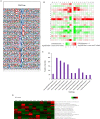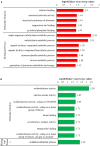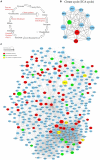The Response of Rhodotorula mucilaginosa to Patulin Based on Lysine Crotonylation
- PMID: 30233516
- PMCID: PMC6129574
- DOI: 10.3389/fmicb.2018.02025
The Response of Rhodotorula mucilaginosa to Patulin Based on Lysine Crotonylation
Abstract
Patulin (PAT) is a mycotoxin produced by some Penicillium, Aspergillus, and Byssochlamys species. Rhodotorula mucilaginosa is able to degrade PAT in vivo as well as in vitro, up till date, the process and molecular mechanism(s) involved patulin degradation still remains unknown. Protein lysine crotonylation (Kcr) plays an important role in regulating chromatin dynamics, gene expression, and metabolic pathways in mammals and eukaryotes. Investigation of the Kcr changes accompanying degradation of patulin in R. mucilaginosa were observed to investigate the mechanisms of patulin inhibition. Tandem mass tag (TMT) labeling and Kcro affinity enrichment, followed by high-resolution LC-MS/MS analysis, were used to perform quantitative lysine crotonylome analysis on R. mucilaginosa. Consequently, 1691 lysine crotonylation sites in 629 protein groups were identified, among which we quantified 1457 sites in 562 proteins. Among the quantified proteins, 79 and 46 crotonylated proteins were up-regulated and down-regulated, respectively. The differentially up expressed modified proteins were mainly involved in tricarboxylic acid cycle and gluconeogenic pathway. The differentially down expressed Kcr proteins were mainly classified to ribosome and carbohydrate transport and metabolism. Bioinformatic analyses were performed to annotate the quantifiable lysine crotonylated targets. Moreover, interaction networks and high confidence domain architectures of crotonylated proteins were investigated with the aid of bioinformatic tools, and these results showed that there was an increase in the number of yeasts with crotonylated proteins. The results also provided information on the various roles of crotonylation, which are involved in PAT degradation.
Keywords: Rhodotorula mucilaginosa; degradation; histone lysine crotonylation; patulin; post-translational modification.
Figures





Similar articles
-
Crosstalk between proteins expression and lysine acetylation in response to patulin stress in Rhodotorula mucilaginosa.Sci Rep. 2017 Oct 18;7(1):13490. doi: 10.1038/s41598-017-14078-5. Sci Rep. 2017. PMID: 29044224 Free PMC article.
-
Large-scale lysine crotonylation analysis reveals its potential role in spermiogenesis in the Chinese mitten crab Eriocheir sinensis.J Proteomics. 2020 Aug 30;226:103891. doi: 10.1016/j.jprot.2020.103891. Epub 2020 Jul 4. J Proteomics. 2020. PMID: 32629196
-
Ammonium triggered the response mechanism of lysine crotonylome in tea plants.BMC Genomics. 2019 May 6;20(1):340. doi: 10.1186/s12864-019-5716-z. BMC Genomics. 2019. PMID: 31060518 Free PMC article.
-
Emerging roles of non-histone protein crotonylation in biomedicine.Cell Biosci. 2021 May 31;11(1):101. doi: 10.1186/s13578-021-00616-2. Cell Biosci. 2021. PMID: 34059135 Free PMC article. Review.
-
Functions and mechanisms of lysine crotonylation.J Cell Mol Med. 2019 Nov;23(11):7163-7169. doi: 10.1111/jcmm.14650. Epub 2019 Sep 1. J Cell Mol Med. 2019. PMID: 31475443 Free PMC article. Review.
Cited by
-
Generation of BSA-capsaicin Nanoparticles and Their Hormesis Effect on the Rhodotorula mucilaginosa Yeast.Molecules. 2019 Aug 1;24(15):2800. doi: 10.3390/molecules24152800. Molecules. 2019. PMID: 31374810 Free PMC article.
-
The Function and related Diseases of Protein Crotonylation.Int J Biol Sci. 2021 Aug 9;17(13):3441-3455. doi: 10.7150/ijbs.58872. eCollection 2021. Int J Biol Sci. 2021. PMID: 34512158 Free PMC article. Review.
-
Protein lysine crotonylation: past, present, perspective.Cell Death Dis. 2021 Jul 14;12(7):703. doi: 10.1038/s41419-021-03987-z. Cell Death Dis. 2021. PMID: 34262024 Free PMC article. Review.
-
Quantitative Proteomic Analysis Reveals Important Roles of the Acetylation of ER-Resident Molecular Chaperones for Conidiation in Fusarium oxysporum.Mol Cell Proteomics. 2022 May;21(5):100231. doi: 10.1016/j.mcpro.2022.100231. Epub 2022 Apr 8. Mol Cell Proteomics. 2022. PMID: 35398590 Free PMC article.
-
Comprehensive Profiling of Paper Mulberry (Broussonetia papyrifera) Crotonylome Reveals the Significance of Lysine Crotonylation in Young Leaves.Int J Mol Sci. 2022 Jan 21;23(3):1173. doi: 10.3390/ijms23031173. Int J Mol Sci. 2022. PMID: 35163093 Free PMC article.
References
LinkOut - more resources
Full Text Sources
Other Literature Sources

